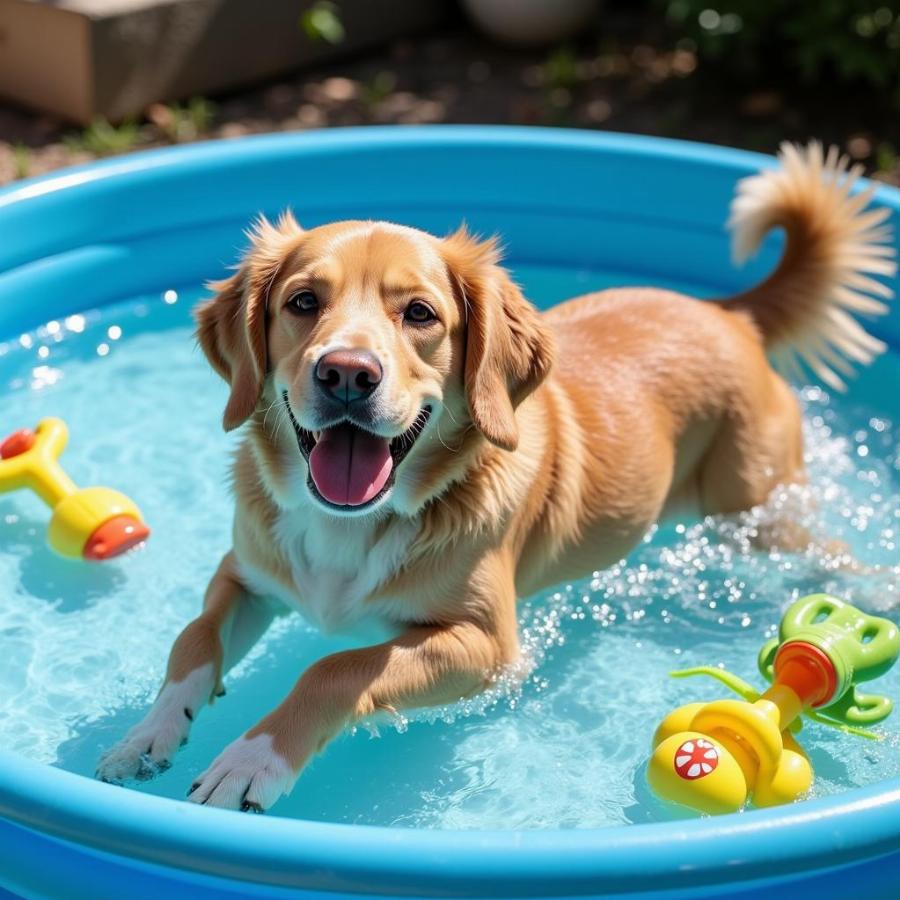Plastic pools for dogs offer a fantastic way to help your furry friends beat the summer heat. They’re a relatively inexpensive, easy-to-set-up, and fun way for your dog to cool down and enjoy the outdoors. From choosing the right size to maintaining the pool’s cleanliness, this guide covers everything you need to know about selecting and using a plastic pool for your beloved canine companion.
Choosing the Right Plastic Pool for Your Dog
Selecting the perfect plastic pool depends on your dog’s size, breed, and activity level. A small, shallow pool is ideal for smaller breeds or puppies, while larger, more active dogs will benefit from a more spacious option. Consider a hard plastic kiddie pool for dogs for durability.
For energetic dogs who love to splash and play, a deeper pool might be more suitable. However, ensure the pool isn’t so deep that your dog struggles to get in and out comfortably. Remember, safety is paramount!
Setting Up Your Dog’s Plastic Pool
Finding the right location for your dog’s pool is essential. Choose a level surface in a shaded area to prevent the water from heating up too quickly and causing discomfort to your dog. Ensure the area is free of sharp objects and debris. Once you’ve chosen the location, simply inflate the pool (if inflatable) or assemble it according to the manufacturer’s instructions.
Maintaining a Clean and Safe Pool Environment
Regular cleaning is crucial to prevent the growth of algae and bacteria. Empty the pool after each use, scrub it clean with a pet-safe cleaner, and rinse it thoroughly. Refill the pool with fresh water before each use. Always supervise your dog while they’re in the pool, especially if they’re not strong swimmers.
Keeping the Water Fresh and Clean
Adding a small amount of dog-friendly pool chemicals can help maintain water clarity and prevent bacterial growth. However, avoid using harsh chemicals that could irritate your dog’s skin. Always follow the manufacturer’s instructions for proper dosage and application. Consider a plastic swimming pool for dogs with a built-in filter for easier maintenance.
How often should I clean my dog’s plastic pool?
Ideally, you should clean your dog’s plastic pool after every use. This will prevent the build-up of dirt, bacteria, and algae. For less frequent use, cleaning every few days is usually sufficient.
Introducing Your Dog to Their New Pool
Some dogs may be hesitant to enter the pool at first. Encourage them with their favorite toys or treats. Never force your dog into the pool, as this could create a negative association. Patience and positive reinforcement are key!
 Chó bơi trong bể bơi nhựa
Chó bơi trong bể bơi nhựa
Benefits of a Plastic Pool for Dogs
A plastic pool provides numerous benefits for dogs, including:
- Relief from the heat: A cool dip in the pool is a refreshing way for your dog to escape the summer heat.
- Exercise and fun: Swimming is a great low-impact exercise for dogs of all ages and abilities.
- Mental stimulation: Playing in the water can provide mental stimulation and prevent boredom.
- A safe and controlled environment: A plastic pool offers a safe and controlled environment for your dog to enjoy the water.
Conclusion
A plastic pool for dogs is a fantastic investment for keeping your furry friend cool and entertained during the warmer months. From providing relief from the heat to offering a fun way to exercise, hard plastic swimming pools for dogs offer a range of benefits. By following the tips outlined in this guide, you can ensure your dog has a safe, enjoyable, and refreshing summer experience.
FAQ
- What size plastic pool should I get for my dog? The ideal size depends on your dog’s breed and size. Measure your dog’s length and width to determine a suitable pool size.
- Can I use chlorine in my dog’s plastic pool? Avoid using chlorine, as it can irritate your dog’s skin and eyes. Opt for pet-safe pool chemicals instead.
- How often should I change the water in my dog’s pool? It’s best to change the water after each use to maintain hygiene.
- What type of plastic is safe for dog pools? Look for BPA-free, non-toxic plastic to ensure your dog’s safety.
- Where should I place my dog’s plastic pool? Choose a level, shaded area to prevent the water from getting too hot.
More helpful resources:
Beaut Dogs: Your Ultimate Guide to Canine Companions
Beaut Dogs is your one-stop resource for all things dog-related. We provide comprehensive information on dog breeds, care, training, and much more. When you need expert advice, email us at [email protected] for detailed and accurate answers. We are committed to providing valuable insights and resources for dog lovers everywhere. Visit us at https://beautdogs.com to learn more.